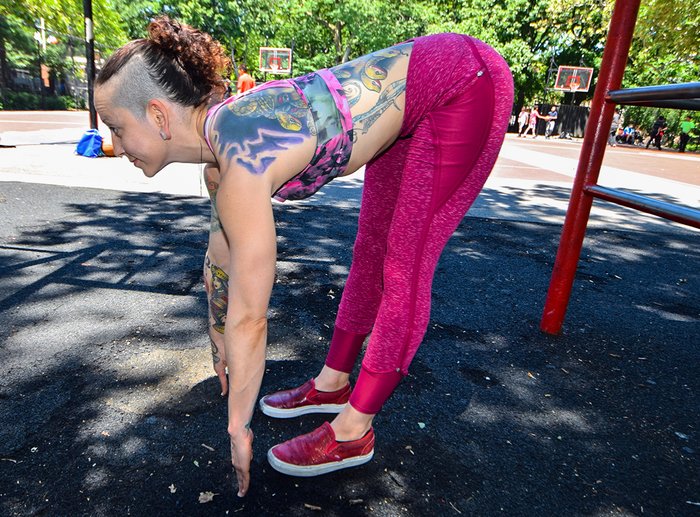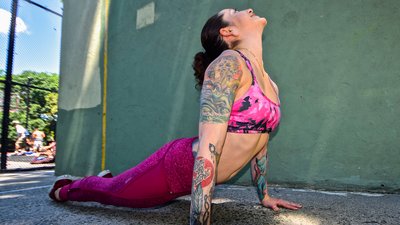Excuses, excuses, excuses. I hear them all the time:
- "I want to go to yoga, but I'm not flexible enough."
- "Yoga is for hippies and people who don't lift weights."
- "I don't have time to go to a class."
Listen, no one is making you go to yoga, but you're missing out on some serious self-care if you don't. I consider it to be in the same category as things like adhering to a healthy diet, getting a massage, or doing some strategic foam rolling, in that it has a slightly mysterious ability to make everything else you do a little better. There is a reason this modality has been around for over 5,000 years. That's longer than kettlebells, dumbbells, barbells, and just about everything else you'll find.
The definition of yoga means "to yoke" or unite, and when paired with strength training, it is simply a match made in the stars. Strength training is a form of repetitive stress on your body, which is important, but it also needs to be balanced to provide its biggest benefits. Adding a bit of yoga into your daily routine can help you improve your focus and bodily control, train with better form, and recover better after you train.
If you spend a lot of time strength training, you likely find that you are tight in muscle groups like the hamstrings, pecs, and shoulders. These problem areas are common no matter if you move big barbells, swing or press kettlebells, or do nothing but bodyweight training. Even if you don't strength train, you're likely suffering from less-than-perfect posture. In both cases, you can benefit from learning and practicing a basic yoga sequence known as the Sun Salutation.
Rise with the Sun
The Sun Salutation links several of the fundamental yoga poses into a flow. Along the way, it also stretches and engages all the major muscle groups in your body, including your chest, back, abs, arms, and legs. It also provides gentle strengthening to joints such as your ankles, wrists, hips, knees, and elbows. The sequence touches pretty much everything, which is one reason why it's a non-negotiable feature in the opening of most yoga classes. It can even be an entire practice unto itself.

There are many different variations of the sun salutation that you may encounter. This is how to perform the most basic version. Pay attention to the breathing cues to get the most out of it!
- Begin standing upright with your feet together and arms at your sides. This is known as Mountain Pose.
- On an inhale, reach your arms overhead, touching your palms together and lengthening through your spine.
- Exhale and fold forward to touch your toes. Bend your knees to touch your feet if you are unable to do so with your legs straight.
- On your next inhale, rise halfway up, allowing your gaze to shift forward and your spine to extend. Your back should be flat in this position with your fingers on your shins, or on the ground if you have the flexibility.
- Exhale and place your palms flat on the ground framing your feet as you step one leg back to a low lunge. Your chest should be resting on your front knee and your back leg should be fully extended as you balance on the ball of your rear foot. Then step your lead foot back, bringing your feet together into a plank position.
- Keeping your arms close to your body and your abs engaged, begin bending your elbows and slowly lower yourself into chaturanga dandasana, or the bottom of a push-up. At the bottom position, your body should be in a straight line from your shoulders to your heels, with your elbows bent just past 90 degrees. You can modify this pose by lowering your knees to the ground for more support.
- On your next inhale, roll to the tops of your feet and press away from the ground, straightening your arms and arching your spine into the upward-facing dog position. Broaden through your collarbones as you squeeze your shoulder blades down and back and gaze upwards.
- Your legs should be firm and hovering about an inch off the ground as you press down through the tops of your feet and hands. If you feel any pressure in your lower back, bend your elbows and keep the front of your hips and thighs connected to the ground to minimize the arch in your spine. This is known as Cobra Pose.
- Take a deep breath in as you tuck your toes under and press away from the ground, raising your hips upward so your body resembles the letter "A." This is the classic Downward-Facing Dog Pose. Your legs and arms should be active and engaged, with your head hanging as you look toward your thighs. Eventually, you want your heels to be in contact with the floor, but if they're not, either bend your knees or allow your heels to hover a few inches from the ground.
- From Downward-Facing Dog, lift one leg into the air, stepping that foot up between your hands back to a low lunge position. Then step your other foot up to meet it. Exhale and fold forward.
- Finally, inhale and rise with a flat back to that halfway-up position (step 4) again, then to Mountain Pose. Repeat the sequence, remembering to alternate which leg you lunge with.
It may look like a lot on paper, but with just a little practice it becomes a seamless flow that you'll have no trouble remembering. Once you've got it down, you can make it more challenging by adding a pair of small jumps: jumping back into chaturanga instead of stepping one leg at a time, and jumping forward between your hands from Downward-Facing Dog Pose.
When and How to Use the Sun Salutation
The Sun Salutation is a pretty perfect warm-up at the start of your session. If you follow the common programming of doing 12 rounds, or six per side, you'll feel warm, mobile, and ready for whatever comes next, be it overhead work like handstand push-ups or kettlebell presses, squat variations, or practicing that pull-up. It can also be a cool-down at the end of your workout, stretching out what's tight from training.

No matter how you use it, remember that each transition in the sequence is done to the tune of your breath, fully inhaling and exhaling during each movement. Ideally, you want to be breathing in and out through your nose.
Once you get comfortable with it, you can also do dedicated sessions that are nothing but Sun Salutations, in numbers of 20, 30, 50, or more. In fact, many hardcore yogis will perform 108 Sun Salutations in a single practice, as 108 is considered a sacred number in Hinduism. That may sound like an epic physical—and mental—challenge right now, but if you could do it, there's no doubt you'd see incredible carryover to everything you do in the gym, and how you feel outside of it. And as an added benefit, your excuses for not doing yoga would all disappear.
There is no substitute for attending a well-taught 60-90-minute yoga class, but when you can't do it, or before you get started on your journey, let the Sun Salutation help. Start by practicing it a few times on each side, and when you're ready, give the 108 Sun Salutation Challenge a try!

